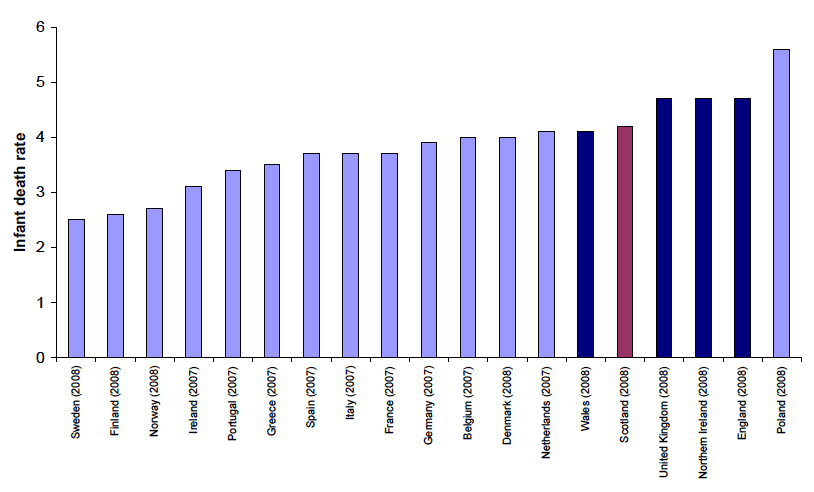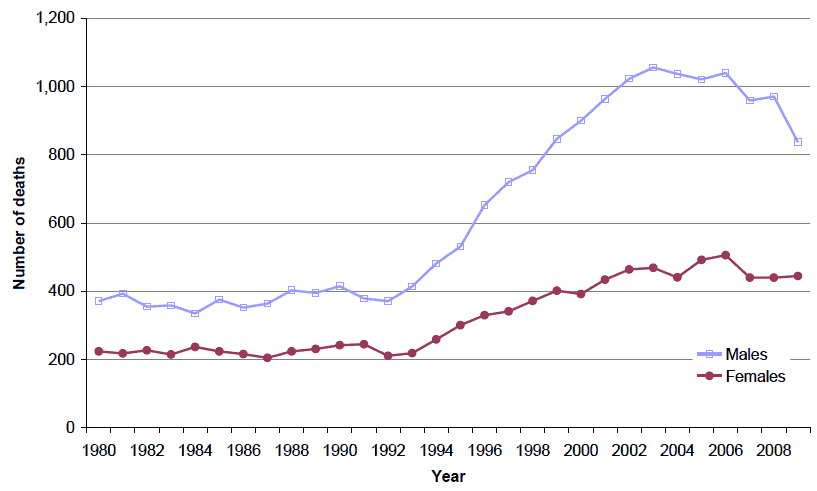
Numbers
53,856 deaths were registered in Scotland in 2009. This was 1,844 (3.3 per cent) fewer than in 2008, and was the lowest total recorded since the introduction of civil registration in 1855.
Figure 2.1 on page 25 shows that from 1951 up to the early 1990s the annual number of deaths remained relatively stable at about 60-65,000 a year. The total then declined slowly to just under 55,100 in 2006 which, until 2009, had been the lowest annual total recorded.
Causes of death
Table 3.1 shows major causes of deaths, by age group. In 2009 more than half of all deaths were due to the so-called ‘three big killers’. There were 15,187 deaths from cancer (28 per cent of all deaths), 8,274 deaths from ischaemic (coronary) heart disease (15 per cent of all deaths) and 4,906 deaths from cerebrovascular disease (stroke) (9 per cent of all deaths).
Since 1980, the total number of deaths from these causes has reduced, as shown in Table 3.2, falling from 65 per cent of all deaths during 1980-82 and 1990-92, to 58 per cent during 2000-02 and to 53 per cent in 2009. The proportion of deaths caused by ischaemic heart disease has fallen from 29 per cent in 1980-82 to 15 per cent in 2009, and cerebrovascular disease declined from 14 per cent to 9 per cent. However, the number of deaths from cancer has increased, and as a proportion of all deaths has risen from 22 per cent to 28 per cent.
Death rates, by sex, for some of the most common causes of death are shown in Table 3.3.
Cancer
Of the 15,187 deaths from cancer in 2009, cancer of the trachea, bronchus and lung was the most common type, accounting for over a quarter (27 per cent) of all cancer deaths.
The next most frequent type of cancer death was bowel for men (836 deaths, of which 47 per cent were aged 75 and over) and breast for women (1,002 deaths, of which 43 per cent were aged 75 and over). Death rates for these two causes have been relatively stable in recent years. Cancers of the lymphoid, haematopoietic and related tissue caused 986 deaths and prostate cancer caused 790 deaths.
Over the last 25 years or so, male death rates from lung cancer have fallen by more than a quarter (from 119 per 100,000 population in 1980-82 to 87 in 2009). By contrast, the rates for women, though still lower than those for men, have increased by nearly 80 per cent (from 41 per 100,000 population in 1980-82 to 73 in 2009).
Table 3.1 The most common1 causes of death, Scotland, 2009
Persons |
All ages |
0-14 |
15-34 |
35-44 |
45-54 |
55-64 |
65-74 |
75+ |
|---|---|---|---|---|---|---|---|---|
All cancers (C00-97) |
15,187 |
19 |
85 |
256 |
894 |
2,377 |
4,227 |
7,329 |
Trachea, bronchus and lung (C33-34) |
4,147 |
- |
- |
46 |
194 |
717 |
1,364 |
1,826 |
Bowel (C18-21) |
1,578 |
- |
5 |
17 |
95 |
228 |
416 |
817 |
Breast (C50) |
1,010 |
- |
9 |
54 |
115 |
187 |
204 |
441 |
Lymphoid, haematopoietic etc (C81-96) |
986 |
5 |
10 |
17 |
48 |
128 |
244 |
534 |
Urinary tract (C64-68) |
821 |
1 |
- |
6 |
39 |
95 |
214 |
466 |
Oesophagus (C15) |
746 |
- |
2 |
4 |
54 |
161 |
210 |
315 |
Prostate (C61) |
790 |
- |
- |
- |
8 |
54 |
196 |
532 |
Pancreas (C25) |
691 |
- |
- |
9 |
40 |
104 |
197 |
341 |
Stomach (C16) |
535 |
- |
1 |
12 |
29 |
67 |
145 |
281 |
Other cancers (e.g. bladder, liver, ovary) |
3,883 |
13 |
58 |
91 |
272 |
636 |
1037 |
1,776 |
Ischaemic heart disease (I20-25) |
8,274 |
- |
16 |
109 |
409 |
865 |
1,628 |
5,247 |
Respiratory system diseases (J00-99) |
7,125 |
16 |
31 |
56 |
153 |
487 |
1,215 |
5,167 |
Cereberovascular disease (I60-69) |
4,906 |
1 |
8 |
51 |
119 |
239 |
626 |
3,862 |
Mental + behavioural disorders (F00-99) |
3,327 |
- |
221 |
200 |
126 |
137 |
198 |
2,445 |
Diseases of the digestive system (K00-93) |
3,006 |
1 |
45 |
173 |
367 |
488 |
569 |
1,363 |
Diseases of the nervous system (G00-99) |
1,652 |
15 |
31 |
37 |
85 |
138 |
298 |
1048 |
Accidents (V01-X59,Y85-86) |
1,332 |
21 |
183 |
114 |
117 |
113 |
142 |
642 |
Diseases of the genitourinary system (N00-99) |
1,269 |
- |
2 |
12 |
17 |
45 |
143 |
1050 |
Endocrine, nutritional and metabolic diseases (E00-90) |
873 |
7 |
33 |
22 |
55 |
94 |
182 |
480 |
Certain infectious and parasitic diseases (A00-B99) |
838 |
13 |
11 |
25 |
47 |
69 |
147 |
526 |
Males |
All ages |
0-14 |
15-34 |
35-44 |
45-54 |
55-64 |
65-74 |
75+ |
All cancers (C00-97) |
7,731 |
7 |
35 |
104 |
417 |
1,286 |
2,341 |
3,541 |
Trachea, bronchus and lung (C33-34) |
2,196 |
- |
- |
24 |
102 |
407 |
739 |
924 |
Bowel (C18-21) |
836 |
- |
4 |
10 |
45 |
136 |
248 |
393 |
Breast (C50) |
8 |
- |
- |
1 |
- |
- |
1 |
6 |
Lymphoid, haematopoietic etc (C81-96) |
553 |
3 |
5 |
14 |
32 |
75 |
153 |
271 |
Urinary tract (C64-68) |
492 |
1 |
- |
4 |
23 |
63 |
147 |
254 |
Oesophagus (C15) |
507 |
- |
- |
3 |
45 |
128 |
147 |
184 |
Prostate (C61) |
790 |
- |
- |
- |
8 |
54 |
196 |
532 |
Pancreas (C25) |
309 |
- |
- |
4 |
14 |
52 |
110 |
129 |
Stomach (C16) |
323 |
- |
- |
8 |
14 |
48 |
99 |
154 |
Other cancers (e.g. bladder, liver) |
1,717 |
3 |
26 |
36 |
134 |
323 |
501 |
694 |
Ischaemic heart disease (I20-25) |
4,600 |
- |
9 |
83 |
319 |
652 |
1,088 |
2,449 |
Respiratory system diseases (J00-99) |
3,272 |
7 |
20 |
26 |
79 |
260 |
667 |
2,213 |
Cereberovascular disease (I60-69) |
1,841 |
1 |
5 |
29 |
58 |
132 |
328 |
1,288 |
Mental + behavioural disorders (F00-99) |
1,303 |
- |
164 |
152 |
90 |
88 |
120 |
689 |
Diseases of the digestive system (K00-93) |
1,421 |
1 |
28 |
109 |
231 |
294 |
293 |
465 |
Diseases of the nervous system (G00-99) |
748 |
5 |
18 |
20 |
47 |
78 |
163 |
417 |
Accidents (V01-X59,Y85-86) |
744 |
15 |
153 |
90 |
85 |
77 |
85 |
239 |
Diseases of the genitourinary system (N00-99) |
514 |
- |
1 |
6 |
9 |
24 |
76 |
398 |
Endocrine, nutritional and metabolic diseases (E00-90) |
427 |
4 |
17 |
15 |
30 |
55 |
109 |
197 |
Certain infectious and parasitic diseases (A00-B99) |
383 |
7 |
8 |
18 |
28 |
44 |
77 |
201 |
Females |
All ages |
0-14 |
15-34 |
35-44 |
45-54 |
55-64 |
65-74 |
75+ |
All cancers (C00-97) |
7,456 |
12 |
50 |
152 |
477 |
1,091 |
1,886 |
3,788 |
Trachea, bronchus and lung (C33-34) |
1,951 |
- |
- |
22 |
92 |
310 |
625 |
902 |
Bowel (C18-21) |
742 |
- |
1 |
7 |
50 |
92 |
168 |
424 |
Breast (C50) |
1,002 |
- |
9 |
53 |
115 |
187 |
203 |
435 |
Lymphoid, haematopoietic etc (C81-96) |
433 |
2 |
5 |
3 |
16 |
53 |
91 |
263 |
Urinary tract (C64-68) |
329 |
- |
- |
2 |
16 |
32 |
67 |
212 |
Oesophagus (C15) |
239 |
- |
2 |
1 |
9 |
33 |
63 |
131 |
Pancreas (C25) |
382 |
- |
- |
5 |
26 |
52 |
87 |
212 |
Stomach (C16) |
212 |
- |
1 |
4 |
15 |
19 |
46 |
127 |
Other cancers (e.g. bladder, liver, ovary) |
2,166 |
10 |
32 |
55 |
138 |
313 |
536 |
1082 |
Ischaemic heart disease (I20-25) |
3,674 |
- |
7 |
26 |
90 |
213 |
540 |
2,798 |
Respiratory system diseases (J00-99) |
3,853 |
9 |
11 |
30 |
74 |
227 |
548 |
2,954 |
Cereberovascular disease (I60-69) |
3,065 |
- |
3 |
22 |
61 |
107 |
298 |
2,574 |
Mental + behavioural disorders (F00-99) |
2,024 |
- |
57 |
48 |
36 |
49 |
78 |
1,756 |
Diseases of the digestive system (K00-93) |
1,585 |
- |
17 |
64 |
136 |
194 |
276 |
898 |
Diseases of the nervous system (G00-99) |
904 |
10 |
13 |
17 |
38 |
60 |
135 |
631 |
Accidents (V01-X59,Y85-86) |
588 |
6 |
30 |
24 |
32 |
36 |
57 |
403 |
Diseases of the genitourinary system (N00-99) |
755 |
- |
1 |
6 |
8 |
21 |
67 |
652 |
Endocrine, nutritional and metabolic diseases (E00-90) |
446 |
3 |
16 |
7 |
25 |
39 |
73 |
283 |
Certain infectious and parasitic diseases (A00-B99) |
455 |
6 |
3 |
7 |
19 |
25 |
70 |
325 |
1 The causes are listed in descending order of their total numbers of deaths. International Classification of Diseases codes (ICD10) are also shown.
Table 3.2 Number of deaths from selected causes, by sex, 1980-2009
|
Cancer |
Ischaemic heart disease |
Cerebrovascular disease |
Total deaths from these causes |
These causes as a % of all deaths |
All deaths |
|||||
|---|---|---|---|---|---|---|---|---|---|---|---|
Year |
Males |
Females |
Males |
Females |
Males |
Females |
Males |
Females |
Persons |
Persons |
Persons |
1980-821 |
7,269 |
6,634 |
10,173 |
8,150 |
3,470 |
5,638 |
20,912 |
20,422 |
41,334 |
65% |
64,050 |
1990-921 |
7,664 |
7,324 |
8,964 |
7,846 |
2,913 |
5,029 |
19,541 |
20,199 |
39,740 |
65% |
61,168 |
2000-021 |
7,674 |
7,394 |
6,342 |
5,664 |
2,465 |
4,250 |
16,481 |
17,308 |
33,789 |
58% |
57,761 |
2009 |
7,731 |
7,456 |
4,600 |
3,674 |
1,841 |
3,065 |
14,172 |
14,195 |
28,367 |
53% |
53,856 |
1 Average over 3 year period.
Table 3.3 Death rates from selected causes, by sex, Scotland, 1980-2009
Males - rates per 100,000 population |
|||||
|---|---|---|---|---|---|
|
Cancer |
Ischaemic heart disease |
Cerebrovascular disease |
||
Year |
All types |
Trachea, bronchus and lung |
Prostate |
||
1980-821 |
291 |
119 |
19 |
408 |
139 |
1990-921 |
314 |
111 |
27 |
367 |
119 |
2000-021 |
321 |
93 |
32 |
261 |
101 |
2009 |
307 |
87 |
31 |
183 |
73 |
Females - rates per 100,000 population |
|||||
|
Cancer |
Ischaemic heart disease |
Cerebrovascular disease |
||
Year |
All types |
Trachea, bronchus and lung |
Breast |
||
1980-821 |
247 |
41 |
45 |
304 |
210 |
1990-921 |
278 |
57 |
48 |
297 |
191 |
2000-021 |
288 |
64 |
43 |
216 |
162 |
2009 |
278 |
73 |
37 |
137 |
114 |
1 Average over 3 year period.
Heart disease and stroke
Table 3.3 shows that, in contrast to the rises for cancer, death rates for ischaemic heart disease (coronary heart disease) and cerebrovascular disease (stroke) have significantly declined. Between 1980-82 and 2009, rates for males had fallen by 55 per cent for ischaemic heart disease and 47 per cent for stroke, compared with reductions of 55 and 46 per cent respectively for females.
Some other major causes of deaths
Other major causes of deaths registered in 2009 included:
Alcohol-related deaths
As well as alcoholic liver disease, there are numerous causes of death that are considered to be ‘alcohol-related’. The main additional category is ‘mental and behavioural disorders due to use of alcohol’. There are several other causes that are specifically alcohol related (e.g. alcoholic pancreatitis) as well as some (e.g. oesophageal cancer) where alcohol consumption is only responsible for a proportion of deaths. Following wide consultation, the Office for National Statistics (ONS) proposed a selection of diseases to be used for high-level public health monitoring of alcohol-related deaths. This includes only the causes of death which are regarded as most directly due to alcohol consumption and for which figures can be obtained from the death registration statistics.
On the basis of that definition, there were 1,282 alcohol related deaths in 2009. Figure 3.1 shows that the numbers of alcohol-related deaths for both sexes were relatively stable during the 1980s, but that there were significant increases, particularly for men, during the 1990s and early 2000s. Further analysis of the data shows that the number of deaths generally rose in all age groups, with the largest increases being among those aged 45-59. However, in recent years, the numbers of male deaths have been falling and female deaths appear to have stabilised.
The definition used to produce these figures does not include every kind of alcohol-related death. For example, it does not include deaths as a result of road accidents, falls, fires, suicide or violence involving people who had been drinking, or from some medical conditions which are considered partly attributable to alcohol.
Further information about the definition, and a more detailed
breakdown of the numbers of alcohol-related deaths, are available
from the NRS website, at:
http://www.nrscotland.gov.uk/statistics-and-data/statistics/statistics-by-theme/vital-events/deaths/alcohol-related-deaths
Figure 3.1 Alcohol-related deaths, Scotland, 1980-2009

Probable suicides
In 2009, deaths which, at the time when the data were finalised, GROS had been told were from intentional self-harm numbered 568 (429 males and 139 females). To allow for any under-recording of suicides, it is conventional to combine deaths classified, at that time, as ‘due to events of undetermined intent’ with those for ‘intentional self-harm’, as most of the former are believed to be suicides - so these are the numbers of ‘probable suicides’. The total number of deaths classified to these two groups in 2009 was 746 - a reduction of 97 on the 843 deaths in 2008 and of 92 on the 838 deaths in 2007.
For men, the most frequent cause of these deaths was hanging,
strangulation and suffocation, whereas for women it was poisoning.
Further information about the numbers of probable suicides is
available from the NRS website, at:
http://www.nrscotland.gov.uk/statistics-and-data/statistics/statistics-by-theme/vital-events/deaths/suicides
GROS publishes a wide range of other statistics on causes of death. In some cases, the figures are subject to caveats, for example because of the complexity of the definitions. They are available from the relevant parts of the NRS website (which include some background information on the basis of the statistics):
Main causes of death by age and sex
The main causes of death vary in frequency by age and sex. Accidents were the largest single cause amongst boys aged 1-14, followed by cancer and respiratory diseases. For girls aged 1-14, cancer was the most common cause, followed by diseases of the nervous system.
For males aged 15-34, the largest cause was suicide (intentional self-harm plus events of undetermined intent) followed by mental disorders (almost entirely associated with drug and alcohol abuse) and accidents. For females in this age group, mental disorders was the largest category. Suicide and cancer were the next most common causes.
Mental disorders was the most frequent cause of deaths for males aged 35-44, followed by suicide. For women aged 35-44, cancer was the main cause.
For both sexes and all age groups between 45 and 84, cancer was the main cause of death.
Mortality by age
The average age at death has increased steadily over the past thirty years. Figure 3.2 shows that the average ages at death for cancer, heart disease and stroke have generally increased in line with the average for all deaths.
Figure 3.2 Average age at death, selected causes, Scotland, 1978-2009
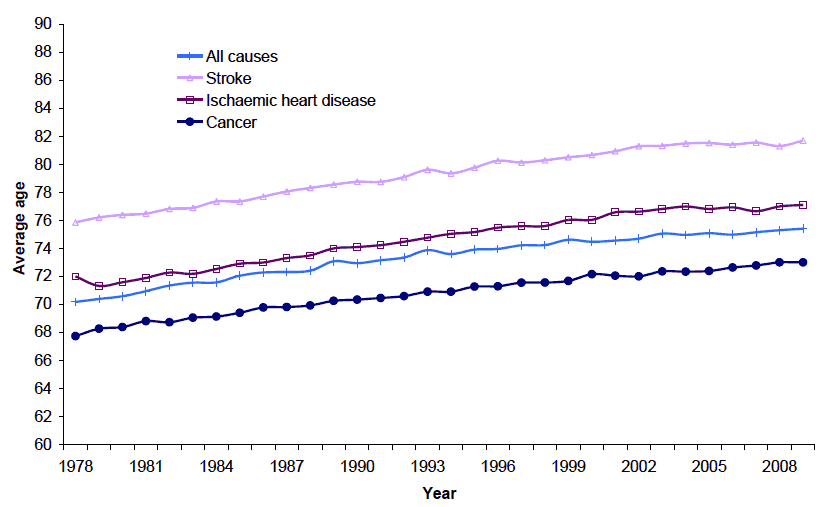
About 60 per cent of deaths in 2009 were of people aged 75 and over, and a further 19 per cent were between the ages of 65 and 74.
The relative stability in the total number of deaths over recent years masks significant reductions in age-specific mortality. Figure 3.3 shows, for both men and women, selected age-specific mortality rates over the last quarter of a century relative to the 1981 rates. The three age groups shown (45-64, 65-74 and 75 and over) account for around 95 per cent of all deaths.
At all these ages, there have been greater improvements in male than in female mortality. In the 45-64 age group, the death rates for men and women dropped by 50 per cent and 44 per cent respectively. In the 65-74 age group, males showed an improvement of 49 per cent compared to 43 per cent for females. The greatest differential is in the 75 plus age group, where male mortality has fallen by 33 per cent compared to only 19 per cent for females. These changes have narrowed the difference between female and (traditionally higher) male mortality.
Figure 3.3 Age specific mortality rates as a proportion of 1981 rate, 1981-2009
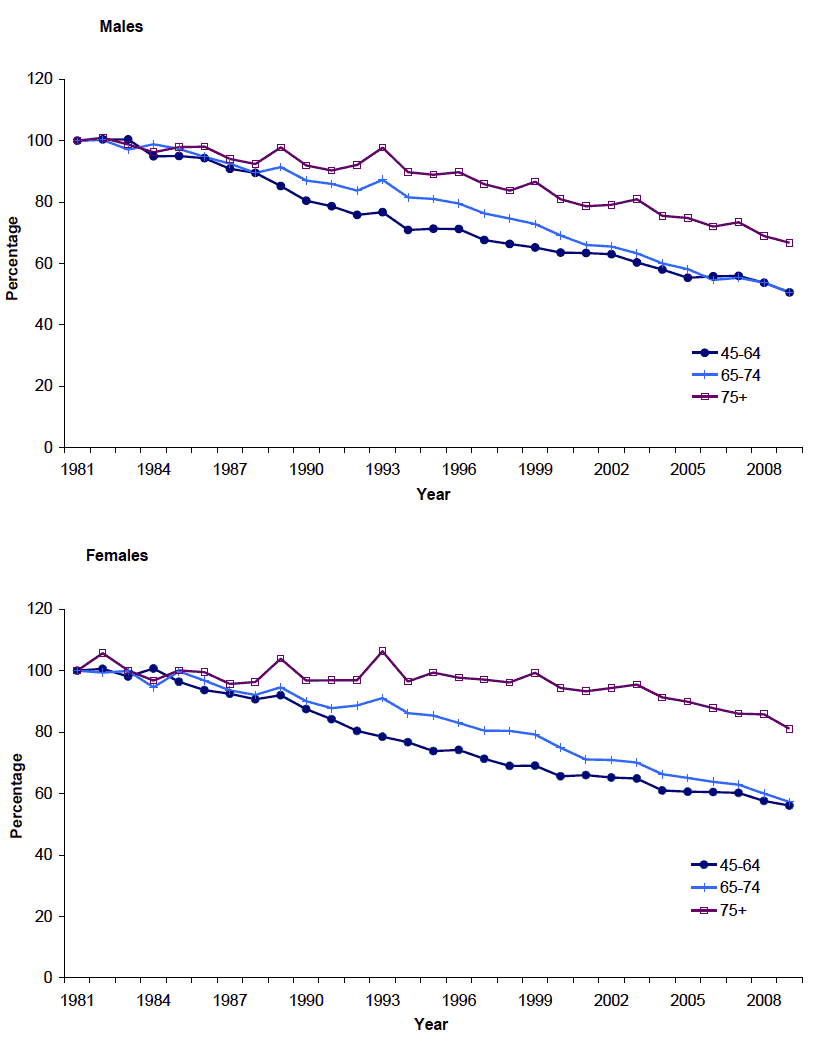
Geographical variations in mortality levels
Standardised mortality ratios (SMRs), which compare local death rates with death rates in Scotland as a whole, taking account of the different population structure of each area, are shown in Figure 3.4. Five of the 32 Scottish Council areas have a standardised mortality ratio that is more than 10 per cent higher than the Scottish value of 100. These are all in West Central Scotland. The worst, Glasgow City, is 27 per cent higher than the Scottish average. At the other end of the scale, 7 of the 32 Council areas have a standardised mortality ratio that is more than 10 per cent lower than the Scottish average. The lowest was East Dunbartonshire which was 23 per cent below (or better than) the Scottish average.
Figure 3.4 Standardised mortality ratios, by Council area, 2009
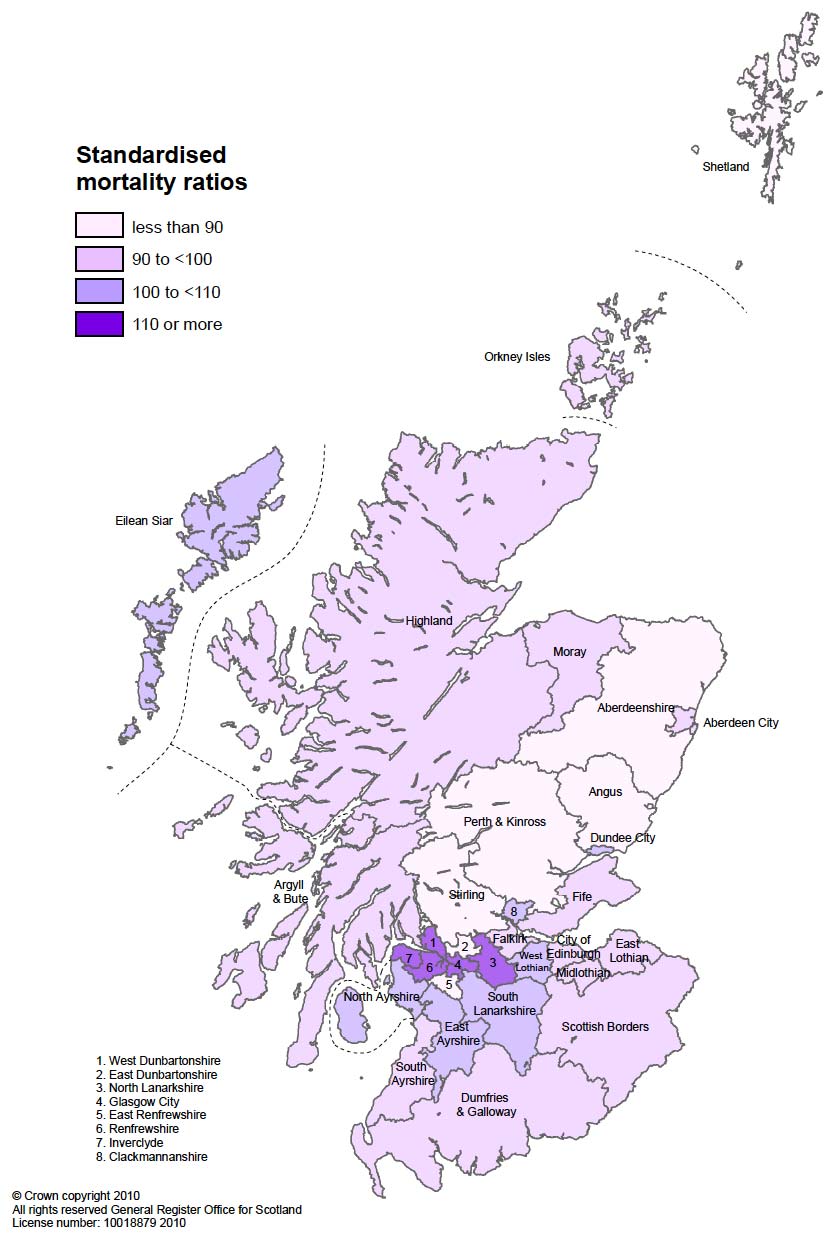
Similarly, standardised mortality ratios can be calculated for each of the different parts of the United Kingdom, and compared with the overall UK figure. The standardised mortality ratio for Scotland is about one-sixth (17 per cent) higher than the UK figure.
Using 2008 data, the latest available, Figure 3.5 compares the death rates for the constituent countries of the UK for selected causes after adjusting for differences in age structure, by applying the European Standard Population age structure. (The results are on a different basis from those of previous reports which used the UK population age structure as the standard.) The Scottish rates for cancer, ischaemic heart disease, and cerebrovascular disease (stroke) are well above the rates for the other countries of the United Kingdom, for both men and women.
Figure 3.5 Age-adjusted mortality rates, by selected cause and sex, 2008
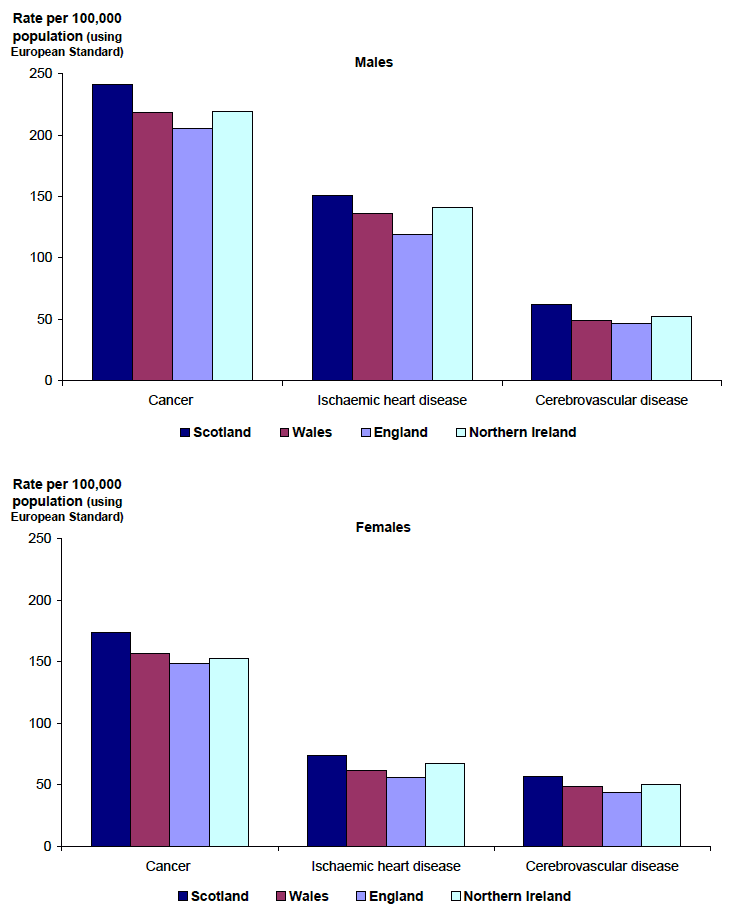
Appendix 1, Table 3 on page 110 shows the death rate for each of the European Union member states, and for some other countries in Europe. These are so-called "crude" death rates. They are calculated by expressing the number of deaths per thousand population. As a result, they do not take account of differences in the sex and age structures of the countries' populations. All else being equal, a country with an unusually high proportion of its population in the younger age groups could have an unusually low ‘crude’ death rate. So, though the figure for Scotland is higher than those for most of the countries that are shown, this could to some extent be due to the structure of the Scottish population. A better way to compare Scotland's mortality with other countries' is to use the estimates of life expectancy for each country (see Chapter 4).
Stillbirths, perinatal deaths and infant deaths
There were 317 stillbirths registered in Scotland in 2009. Stillbirths are registered separately from live births and from deaths, and so are not included in either of those figures.
Perinatal deaths consist of stillbirths plus deaths in the first week of life (the latter are registered as live births and as deaths). There were 120 deaths of children who were aged under one week old, so there was a total of 437 perinatal deaths.
Infant deaths are deaths in the first year of life, all of which are registered as live births and as deaths. In total, 235 infant deaths were registered in Scotland in 2009 (including those who died in the first week of life).
As can be seen in Figure 3.6, there have been significant improvements in the rates for stillbirths, perinatal deaths and infant deaths in the period since 1971. The stillbirth rate has reduced from 13.1 per 1,000 total births (live and still) in 1971 to 5.3 in 2009, despite a change in the definition of stillbirths in 1992 which reduced the minimum period of gestation from 28 weeks to 24 weeks (thus increasing the numbers classified as stillbirths). The perinatal death rate fell from 24.5 per 1,000 total births in 1971 to 7.4 in 2009 and the infant death rate fell from 19.9 per 1,000 live births in 1971 to 4.0 in 2009.
Figure 3.6 Stillbirth, perinatal and infant death rates, per 1,000 births, Scotland 1971-2009
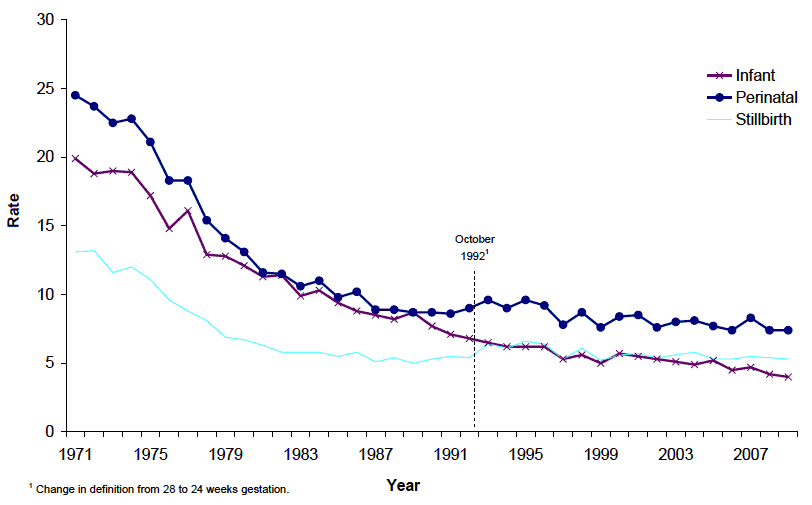
Whilst the current rates are comparable to those for the UK as a whole, Figures 3.7 and 3.8 show that there are several European countries that have significantly lower rates (see also Appendix 1, Table 3).
Figure 3.7 Stillbirth rate per 1,000 live and still births, selected countries, latest available figures
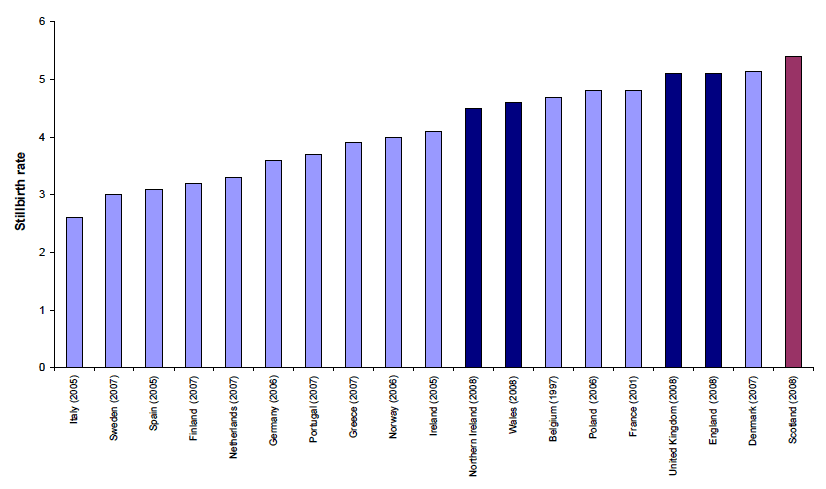
Figure 3.8 Infant death rate per 1,000 live births, selected countries, latest available figures
